
André Hellmann
Chef-Stratege der netzstrategen
Ever since we started the company, we made a difference between the compensation the company offers and the money (as salary and bonus payments) that each person receives. The salary clearly is an important and major part of the compensation a company offers to their employees (in lack of a better term). But in our company and within our values, it cannot be the only “thing” a person receives in exchange for the time and ideas they invest into the joint venture (please understand this term literally).
We never considered it contemporary that people only come to work for money that eases the pain they experience at their workplace. We are joining forces for common values. A common understanding of digital things. A shared passion and similar goals.
Salary - money makes the world go round
Nevertheless, monetary aspects have to work not just individually per person to make ends meet – but also with the outer world so nobody has to seriously consider all the different job offers we all receive (even me – as the owner and CEO of the company…). A lesson we learned in 2018 when the circumstances in the lives of many of our colleagues changed due to kids and house payments etc. and all of a sudden the salary part took a much greater weight in the equation.
To be honest, we probably made the mistake and ignored this topic for way too long. We relied on the common and non-monetary aspects to be in in great condition, discussed and developed those, increased the salaries annually (based on the company development) and paid bonuses as far as the liquid assets allowed.
It became clear as people were with the company for more than five years and life around the company happened with marriage, kids and mortgages, that there is a need for more transparency and a more foreseeable increase of the salary you can count on and plan with.
On the other hand, it is important for the economic part of the company to know that the monetary expectations of the team are realistic (or have to be discussed early) and actually feasible, considering the status and the evolution of the company’s financials and external circumstances.
It has to be commonly known what each and every single person with the company has to do, to fulfill the business plan and make the growing salaries possible. And only if the company is on good shape and if we fulfill our business plan we can also fulfill our compensation model. Those things heavily depend on each other.
So from now on we talk more frequently and more concrete about our compensation model and how we want to pay salaries.
Compensation - how our model works
So what we created as a compensation system is based on several pillars and – as our DNA dictates – is more a promise than a constitution:
Values as the foundation
The first pillar consists of our values. They are anchored within the company and if you break our values we need to have a talk. If we don’t live up to our values, collaboration won’t be fun anymore and the results as well as the customer experience will suffer. We don’t want that. Nobody does.

Our codex as the universal agreement
The second pillar is a codex we created, that breaks down our business model to what every single person has to have on the radar as far as personal performance goes. How many hours do I book, how many are billable, and how many are actually being billed? And what do I do if one of them goes out of hand? You could call this the essential equation of the company everybody has to contribute to. And it can be checked and managed, and there’s an objective truth to these KPIs.

Common monetary benefits
Thirdly, we listed all the non-monetary and also non-obligatory things the company does and offers to make everybody’s lives easier, more convenient and working more fun. This was actually done by a task force from different teams and disciplines, so it was not only accounting and bookkeeping ticking boxes but actually collected from the day-to-day business.

Individual salary levels
The fourth part is a transparent and known salary structure, that is based on individual factors and that may not be entirely objective. It boxes the complexity per person somewhat, so individual conversations about the salaries are less extensive. The individual factors have been prepared by the mentioned task force and have been discussed and filtered by another group, to prepare the conversation and decision-making process in a meeting with all people in the company at the table.

So how does this salary structure work? Well – first off, we had to equalize factors that everybody can actually influence and that are important to the company. We broke those down into these four factors:
- working experience in the field/s you are responsible for within the company
- width and/or depth of skills within your discipline and the development of the skillset
- working experience inside our company (though this effect dims over time)
- engagement – meaning responsibility, proactivity, attention and identification with our work, topics and projects
Experience as the main differentiation
Whenever a new netzstrategian joins us, we look at the practical experience in the individual discipline and field of work the person will cover in our company. Internships, student jobs and the time on educational training (german: Ausbildungszeit) do not count towards the years of practical experience on the job since the carried responsibility and self-sufficiency are usually much lower than in a regular position. This defines where the new strategian is situated within our four salary brackets and where (on the individual scale) they start (the latter is a more subjective discussion and always in relation to other applicants and experience).
Clear outlook for growth
To define the potential growth of the salary we defined, we divided the time a netzstrategian works in the company into four brackets, which each represent four years you’d stay within a bracket (if you start at the beginning). And we broke down the annual growth potential into three parts:
- development of relevant skills (to be defined within the team for each person)
- responsibility for coordination with the team, disciplines, projects or beyond
- responsibility for clients, projects and budgets
Shared responsibility for annual goals
So each year the disciplines come together and define on their own, who should learn what, improve upon what skill or take care of which coordination/administration tasks. With this agreement, we settle on salaries for the upcoming year if the objectives have been accomplished, others have been defined or if there are good reasons why things didn’t happen the planned way. This can be up to EUR 2.000 per person every other year.
Furthermore, we increase the annual salary by EUR 1.000 after 12, 36 and 60 months since company affiliation makes a big difference when it comes to working together (the longer, the better/easier since processes are learned and people are known) and how much a person can help onboard new teammates. But we believe this effect is maxed out after five years.
And we increase the salaries to level the inflation between 0-2% every other year just to make sure we adapt to inflation and the constantly growing cost of living (due to more and more expensive digital gadgets :-D). The inflation rate will be defined for every year and we take the average over the the two years to define the applied rate.
We also would like to continue to pay two bonuses per year but since we dramatically increased the yearly promised salary we’ll see how this plays out and what it does to our bank account.
So how does this go down in real life? Here are the steps and an example:
- When hired, we find your initial salary based on your working experience in the relevant field based on our matrix.
- After one year with us, your annual salary is raised by EUR 1.000. Just because we know how much it helps to be working with one another for a longer period of time.
- In your second year with us – in the quarter that you joined us – we’ll discuss your raise based on the above mentioned criteria and up to EUR 2.000 more per year. And we’ll increase the previous salary by the percentage to level the current inflation.
- After your third year there’ll be another additional EUR 1.000 more per year since we hopefully grew together even more and became more efficient.
- In the fourth year we’re not just looking into your goals and where your team is at with its business goal – but also more into your personal development and if you may have outgrown the original salary bracket by taking over more responsibilities or skillful leadership. And there’s another inflation addition to your base salary.
- The fifth years bringt another EUR 1.000 additional to your base salary. We should be close to Nirvana in working together.
- From here on out, every other year we’ll review your personal and the team business goals together – and every four years we’ll do a bigger check if you are still in tune with your personal goals and your role inside the company.
The emergency break for this system on an individual as well as the collective level, is the codex we all agreed upon. If we don’t all stick to these equations and contribute to the economic part of the company, there’s no way we can keep this promise. But this is why we talk and continue to shape and adapt this model. Every time we look at it we learn something.
So we have high hopes that with this model we have found a good compromise between all the things that are important to us: Fun times at work, great project, good collaboration and personal financial foreseeability.
If this speeks to you, we would like to invite you to take a look at our job vacancies.





